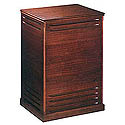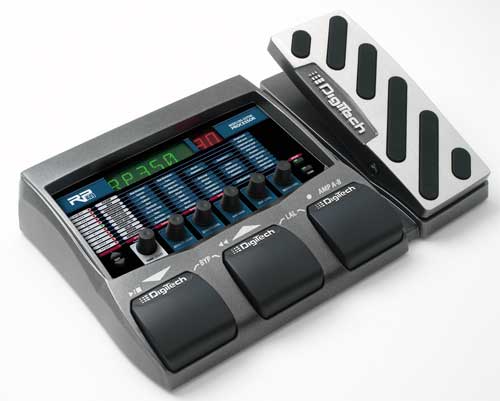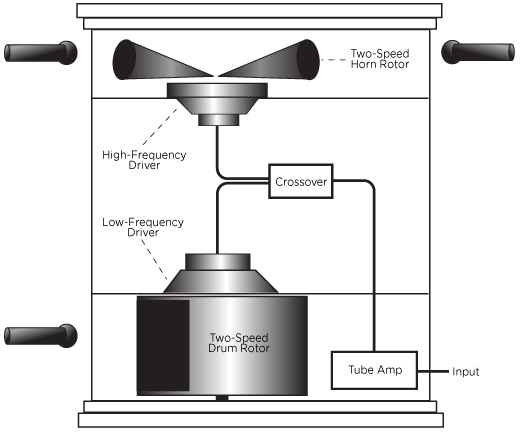
Mike's Ultimate Leslie Speaker Pedal Page

If owning your own full sized rotary speaker isn't practical, before buying a leslie speaker pedal one must ask one's self: "Are my amp and speakers right for the rotary speaker sound?"
Anyone who's listened to the samples from my Leslie Speaker Worship page knows that as wonderful as leslie guitar can be, the fact is that, like any other pedal, even a high quality leslie speaker simulator can sound like sonic sewage through a particular rig, like maybe even your rig. You simply won't know the results until you attach one to your rig and give it a spin...preferably at some of the various venues where you'll be using it.
You can roll the dice, but there is a better way.

At left is a Digitech RP-350 multi-effects guitar pedal. Available for about $125.00 off Craigslist, possession of this monster will afford you the ultimate introduction into the world of the rotary speaker, the univibe, the vibro-pan, and practically every other modulation efx known to man.
The purpose of this page is to provide instructions for the set up of the Digitech RP-350 guitar pedal to achieve optimum Leslie-ocity.
What's the big deal, you ask? True, one can simply adjust all 70 of the user definable patches by editing the 'chorus/fx' section of the configuration program, and turn on the rotary speaker effect, that's just scratching the surface.
Best to take this step by step.
Job #1 is to restore the factory default configuration, which can be found on page 28 of the owners manual. And sure, this will delete all previous configuration changes, but that's the idea.
Job #2 is to restart the RP-350 and observe the LED to insure that "1.4" appears during boot up. This is the latest firmware level, and anything less requires consulting with the Digitech support site for instructions on applying a firmware upgrade. It's quite easy, but this will also delete all previous patch customizations.
Job #3: To test your rig with the least amount of tonal coloring by the pedal, it's best to set up the amp and cabinet modeling to "DIRECT", and then turn off any wah, compressor, equalizer, noise gate, distortion/overdrive, chorus/fx, delay and reverb too. Save this to patch #1, and call it "DIRECT". Attach the RP-350 to your amp using a high quality instrument cable of the shortest length possible, set your amp for the cleanest of clean channel, and test with your favorite guitar to insure that clean is what your are indeed getting.
Job #4: Edit the DIRECT patch to turn on the 'rotary' speaker emulation in the 'chorus/fx' configuration section. Don't change any of the various parameters at this time.
Job #5: Edit the 'expression' control to enable the control of the 'rate' parameter, so the expression pedal controls the rotational speed of the leslie effect.
Job #6: Save the changes, and test on the clean channel of your amp.
Job #7: Now retest after switching the amp to your favorite overdriven or distorted channel, at your favorite volume, and then retest repeatedly as you back off the gain a little at a time. Be sure to make a note of your favorite settings. Then do this again at a significantly different volume. Again note your favorites.

Job #8: Only after all of the above is done should the other parameters of the rotary speaker effect be adjusted. As they are adjusted, individual patches should be created to permit the study of each rotary parameter. The intensity parameter is much like the "mic placement" parameter of some of the dedicated leslie simulator pedals.
Job #9: After switching back to your amp's clean channel, begin testing with the numerous amp and cabinet modeling which is at the heart of the RP-350. Make note of your favorites, and keep an open mind. Save your favorite patches.
Job #9 coolness: Note the large button labeled "AMP A/B", and understand that the coolest aspect of the RP-350 is the fact that there are 2 amp & cabinet configurations for EACH patch. That's right, you're now blessed with 140 user configurable patches. I encourage you to look at this as rotary-clean and rotary-dirty or lead and rhythm, or lead and boost or whatever.
Job #10: Next, choose a cleaner amp and cabinet models, then test with the various distortion pedal and pre-amp emulations. Fun, Fun, Fun! Hey...this is art, not science. Save favs for later fine tuning.
Job #11: Work with the pair of LFO's which are found in the 'expression' area. LFO1 can be assigned to one task, while LFO2 can work on another task. Theses LFO's, when applied to the lower equalizer variables, can produce a grind which is not so different from that produced by a Hammond Organ with an overdriven leslie speaker attached. Save promising results to patches.
Job #12: Finally, attach the RP-350 to your home stereo, or at least connect a set of quality headphones to the back of the RP-350, and retest all of the patches created during steps #9, #10 & #11. Now you're hearing the modeling as clean and pure as Digitech intended, and in stereo, which isn't necessarily better with rotary speaker simulation. Similar results can be achieved using a pair of keyboard combo amps instead of a guitar amp.
| Patch # | Patch Name | Org Patch | fx | knob 2 | knob 3 | knob 4 | knob 5 | knob 6 |
| 1 | DIRECT | cmpcln | rotary | post | speed var 25-99 | intensity 50 | doppler 25 | x-over 99 |
| 2 | LCMC02 | cmpcln | rotary | post | speed var 25-99 | intensity 50 | doppler 25 | x-over 99 |
| 3 | LCMC03 | cmpcln | rotary | post | 50 | var 30-85 | 50 | 99 |
| 4 | LCMC04 | cmpcln | rotary | post | 40 | 50 | var 10-70 | 99 |
| 5 | LCMC05 | cmpcln | rotary | post | 45 | 50 | 35 | var 1-99 |
| 6 | LCMC06 | cmpcln | univibe-vibrato | post | speed 50 | var 0-99 | vibrato | vol 80 |
| 7 | LCMC07 | cmpcln | univibe-chorus | post | speed 50 | var 0-99 | chorus | vol 80 |
| 8 | LCMC08 | cmpcln | tc chorus | pre | speed 55 | width 75 | intns. var 0-99 | |
| 9 | LCMC09 | cmpcln | tc chorus | post | speed 55 | width 75 | intns. var 0-99 | |
| 10 | LCMC10 | cmpcln | panner vibrato | post | speed 50 | depth 25 | pan var 0-99 | waveform sine |
| 11 | LCMC11 | cmpcln | panner tremolo | post | speed 35 | depth var 0-99 | wave: triangle | |
| 12 | LCMC12 | cmpcln | eh phaser | post | rate var 15-99 | color ON | ||
| 13 | LCMC13 | cmpcln | eh flanger | post | rate 15 | range 45 | color var 0-99 | |
| 14 | DCMC14 | cmpcln | detune | post | shift 15 | level var 0-85 | ||
| with LFO1 on MIDRNG in EQ | ||||||||
| 15 | IDC/AC | dc/ac | rotary | post | 45 | var 0-85 | 25 | 99 |
| 16 | IRECTD | rectfd | rotary | post | 45 | var 0-85 | 25 | 99 |
| 17 | SJMPNL | jmppnl | rotary | post | var 0-99 | 45 | 25 | 99 |
| 18 | OTWNRV | twnrvb | optrem | post | speed var 0-99 | depth 80 | ||
| 19 | HIWATA | hiwatt & fa412 | rotary | post | 45 | var 0-85 | 25 | 99 |
| 20 | SCLNCM | clncmb | rotary | post | Var 0-99 | 45 | 25 | 99 |
| 21 | ICRNCY | crnchy | rotary | post | 45 | var 0-85 | 25 | 99 |
| 22 | SMRCLN | mrclen | rotary | post | var 0-99 | 45 | 25 | 99 |
| 23 | IGRESR | greasr | rotary | post | 45 | var 0-85 | 25 | 99 |
| 24 | IBGBLU | bigblu | rotary | post | 45 | var 0-85 | 25 | 99 |
| 25 | SSMTJZ | smthjz | rotary | post | rate var 5-80 | 20 | 40 | 99 |
| 26 | IPUNK | punk | rotary | post | 45 | var 0-85 | 25 | 99 |
| 27 | SMRK2C | mark 2c + 112 | rotary | post | var 0-99 | 45 | 25 | 99 |
| 28 | IACOUS | acoust | rotary | post | 45 | var 0-85 | 25 | 99 |
| 29 | IRPSDY | rhpsdy | rotary | post | 45 | var 0-85 | 25 | 99 |
| 30 | ICLNFK | clnfnk | rotary | post | 45 | var 0-85 | 25 | 99 |
| 31 | IIB808 | ibanez 808 | rotary | post | 45 | var 5-85 | 25 | 99 |
| 32 | IALGBY | algboy | rotary | post | 45 | var 10-85 | 25 | 99 |
| 33 | SBLUDY | bludly | rotary | post | var 0-99 | 45 | 25 | 99 |
| 34 | SBIGROM | bigrom | rotary | post | var 0-99 | 40 | 25 | 99 |
| 35 | SDERYA | der ya | rotary | post | var 0-99 | 40 | 25 | 99 |
| 36 | IFUZKN | fuzkng | rotary | post | 45 | var 0-85 | 25 | 99 |
| 37 | IPRIDE | pride | rotary | post | 45 | var 0-85 | 25 | 99 |
| 38 | SCHIMY | chimey | rotary | post | var 0-99 | 40 | 25 | 99 |
| 39 | IBRT45 | brit45 | rotary | post | 45 | var 0-85 | 25 | 99 |
| 40 | SVAC15 | Vox AC15 | rotary | post | var 0-99 | 40 | 25 | 99 |
| 41 | SOVRDR | octdvd | rotary | post | var 0-99 | 40 | 25 | 99 |
| 42 | IPHASR | flntas | rotary | post | 45 | var 0-85 | 25 | 99 |
| 43 | IMATCH | Match+TWN212 | rotary | post | var 0-99 | 40 | 25 | 99 |
| 44 | IBRTCM | brtcmb | rotary | post | 45 | var 0-85 | 25 | 99 |
| 45 | IHILBL | hilbly | rotary | post | 45 | var 0-85 | 25 | 99 |
| 46 | ISDLUX | sodlux | rotary | post | 45 | var 0-85 | 25 | 99 |
| 47 | SSTVRA | stvray | rotary | post | var 0-99 | 50 | 25 | 99 |
| 48 | SSUCLY | supcly | rotary | post | var 0-99 | 50 | 25 | 99 |
| 49 | UBLUDR | bludrv | univibe-vibrato | post | 50 | var 0-75 | virato | volume 80 |
| 50 | ICLNBR | clnbrt | rotary | post | 45 | var 0-75 | 25 | 99 |
| 51 | TCOWBY | cowboy | tremolo | pre | 45 | depth var 0-50 | sine | |
| 52 | ISTLLR | stellr | rotary | post | 45 | var 0-90 | 25 | 99 |
| 53 | SOLDSC | oldsch | rotary | post | var 0-99 | 40 | 25 | 99 |
| 54 | IPERTY | perty | rotary | post | 45 | var 5-99 | 25 | 99 |
| 55 | ORGAN1 | Panner | panner | post | speed var 15-49 | intensity 75 | ||
| with MIDRNG on LFO1 & BASS on LFO2 | ||||||||
| 56 | ORGAN2 | Panner | panner | post | speed var 60-99 | intensity 75 | ||
| with MIDRNG on LFO1 & BASS on LFO2 | ||||||||
| 57 | SMARSH | mar 59 bm+410 | rotary | post | 45 | var 0-75 | 25 | 99 |
| 58 | CBGSTM | big strum | chorus | pre | speed var 15-99 | depth 70 | triangle | level 70 |
| 59 | SWOMAN | woman | rotary | post | var 0-99 | 50 | 25 | 99 |
| 60 | SSATCH | satch | rotary | post | var 0-99 | 50 | 25 | 99 |
| 61 | SFAZED | fazed | eh phaser | pre | speed var 0-99 | color on | ||
| 62 | IBIGBD | big n bad | rotary | post | 45 | var 0-85 | 25 | 99 |
| 63 | IBASMN | bass man | rotary | post | 45 | var 0-99 | 25 | 99 |
| 64 | ISLIDR | slider | rotary | post | 45 | var 0-99 | 25 | 99 |
| 65 | SSPNKN | spankin clean | rotary | post | 45 | var 0-99 | 25 | 99 |
| 66 | S-LFO | hazy | rotary | post | var 0-99 | 45 | 25 | 99 |
| with LFO1 on Midrng & LFO2 on Bass | ||||||||
| 67 | SCOOL | cool clean | rotary | post | var 0-99 | 40 | 25 | 99 |
| 68 | SDRIVN | drivin | rotary | post | var 0-99 | 40 | 25 | 99 |
| 69 | ISMOTH | smoothy | rotary | post | 45 | var 0-75 | 25 | 99 |
| 70 | SKCHNK | ka chunk | rotary | post | 45 | var 0-99 | 25 | 99 |
| fx | pre-post | speed | intensity | doppler | x-over | |||
Now granted, we're probably talking about a couple of weekend's worth of work here, and that's just to get the RP-350 prepared to actually begin serious testing that a band, or with a DAW, or at least with apro grade looper.
Keeping in mind that not all rigs sound good with the rotary speaker, possibly the best part of owning an RP-350 is that you will be able to explore the rotary compatibility of an unlimited number of virtual rigs, a tool which can point the budding leslie guitarist in the right direction for that next amp and cab purchase. Don't be surprised if all the testing convinces you that having a 30-40 watt keyboard amp handy is a great idea for practicing with a multi effects pedal at home, particularly when playing live is normally done through a PA System.
Due to a total lack of talent, I don't gig and I'm not even in a band, so I've got my RP-350 attached to my Kenwood receiver via a pair of 1/4" to RCA conversion cables, and played through a pair of 40" tall 4-way Sansui speakers which sit about 10 feet apart. I sometimes experiment with the sound by switching back and forth between the receiver's "stereo" and "virtual surround sound" modes, but it makes almost no difference when modulation effects are involved.
Please don't assume that this RP-350 is what I usually mess with. That fact is that I've sold it, and it's replacement too. Now I have a Crate FTX-30 solid state combo amp which includes not only the rotary speaker effect, but the more versatile "DETUNE" (also called the automatic double tracker or ADT) which is what I practice with most of the time, usually while watching TV. The Crate is feeding a pair of open backed cabinets, the remains of a pair of dead Fender Champion 300 combo amps, each containing a single 10" 8 ohm driver. Each cabinet is roughly 12 feet from the Crate amp, and the nearly 25 feet of total speaker separation works wonderfully with modulation effects, even though it's all mono.
Finally, the occasional minimalist urge is satisfied by playing my guitar through a battery powered Danelectro Bacon n Eggs combination mini-amp and distortion pedal which sits under my chair. No kidding. And while the original intent was to essentially punish myself for all this modulation excess, I've found that the unintended benefit is that the lo-fi tone of the tiny Bacon n Eggs driver is far less distracting while watching the big game, yet it retains the electric guitar edge.
Peace and happiness.
Mike